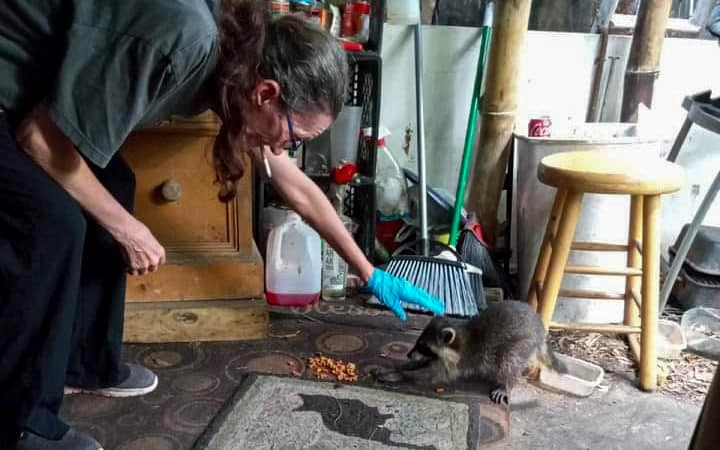Even the mild winters in Florida can bring challenges of survival with the wind and rain.
By Mary Stewart
Florida is notorious for its stifling heat and mild winters, with some homeless people moving to the state for this year round warm weather. But these mild winters can still get cold enough to cause hypothermia, the flu and pneumonia for the homeless.
Last year, the temperature dropped to 23 degrees on Christmas Eve in Central Florida — low enough to potentially cause hypothermia in those who lack a heat source.
Although hypothermia — the malfunctioning of the heart, brain, and kidneys due to dropping body-temperature — is more common when temperatures drop below freezing, this life threatening condition can claim victims when the weather is just above 40 degrees due to wind-chill or rain. And in Florida, nighttime winter temperatures can consistently be in that range.
I have never personally known a fellow homeless person that has been impacted by hypothermia, but that doesn’t take away the possibility for the homeless to die of cold in the Sunshine State. I’ve more commonly seen homeless Floridians fall ill with the flu or pneumonia in the winter, having had the flu once myself while homeless in December, and despite being vaccinated.
Fortunately, my Medicaid paid for Tami-flu and my symptoms were short lived. But most homeless people are uninsured and have no choice but to let the virus take its course.
I’ve also had pneumonia twice. Once in January, and I had to be hospitalized for a week. My other bout oddly occurred during the month of July.
Kitty, who was homeless for many years, also seemed to get sick in the summer. She recalls her fight to stay warm in the winter.
“Lots of blankets and lots of hot chocolate — that’s how I stayed warm and cozy. I actually liked the winters because I had the opportunity to help others stay warm, too. Many of my friends didn’t have a tent or blanket or even a jacket. I was able to share mine with them. I even helped the animals in the winter,” she told me.
I’m more of a coffee person and was always a frequent Dunkin Donuts customer in the winter. In retrospect, my cardboard sign should’ve said ‘Need a hot cup of coffee’ instead of ‘Hungry’ during the winter because that’s what much of my panhandling money went to.
Hot chocolate and tea are more cost-efficient hot beverages to keep the homeless warm throughout winter, though. Instant hot cocoa packets and tea bags can be bought with food stamps, and many convenient stores offer free hot water.
Allen was also homeless on and off since the age of 18. Before moving to Florida, he struggled to survive below freezing temperatures in Kentucky and the Carolinas.
“I’d usually try to find a large cardboard box — like one of those refrigerator boxes — and fill it with blankets. I’d also layer my clothing. I would wear a smaller jacket with a thick jacket or hoodie over it. Sometimes, if it was too cold, I’d sleep in my buddy’s car or in his basement.”
When it came to wintertime, homelessness in Florida was a much needed relief for Allen.
“I didn’t come to Florida because of the weather,” he said. “My wife is from Florida. But winters weren’t an issue anymore. I’d just build a campfire and cover up with blankets in my tent when it got cold. But the summers were way too hot.”
Imagine wearing soaked clothing outdoors when the temperature drops between 40 and 60 degrees. I was shivering and freezing cold.
Allen and Kitty bring up some important points. Blankets and jackets are a must for homeless people in the winter — even in Florida. Sadly, much of our local unhoused population is lacking those items.
Often, blankets and clothing are stolen by other homeless people out of need. Other times, they are discarded by property maintenance. But one of the biggest issues with holding onto those necessities is the rain.
The spring and summer months are more known as theFlorida rainy season, with the winter seen as mostly dry, but it does still rain in the winter — just not as much.
I’ve usually had a tent where I’d store my blankets and extra clothes. I’m very good at stashing my belongings and only dealt with my stash spots and camps being discovered a few times. Even so, I would often get caught in the rain during the winter leaving my socks, jeans, and sweater soaking wet.
Imagine wearing soaked clothing outdoors when the temperature drops between 40 and 60 degrees. I was shivering and freezing cold. Sometimes my stuff would be stored in trash bags and also become damp or my tent would leak, leaving my extra items almost as wet as what I was wearing.
There were times when I had nothing dry to change into, nor did I have a dry blanket to cover up. Trust me, I was miserable. I recall one time when this happened, and a church group happened to bring out socks and blankets — I had never been so grateful.
Campfires are a common heat source for the homeless when the weather gets cold. But it can also present a fire hazard for surrounding homes. One time, my friend Rooster lit a candle in his makeshift tent, and the woods caught on fire. Thankfully, I was there with my phone and was able to call the fire department.
If a tiny candle could cause a fire, building a bonfire at one’s camp for warmth is even more dangerous. It should also be noted that fires create smoke, and smoke draws attention to your camp.
Now, I have used small charcoal grills for cooking and warmth while homeless. The fire was more contained at least. I’d keep the grill a few feet from my tent and away from the brush to prevent a fire. But it didn’t stop nearby homeowners from calling the authorities and complaining.
Since then, I started cooking with a single burner propane stove that doesn’t create smoke. It’s been easier to stay under the radar but does nothing for warmth. In the end, I guess winter survival does boil down to hot cocoa, blankets, and jackets.
As far as winter illness, emergency rooms will treat you if you are uninsured and can perform nose swab tests for the flu and pneumonia. Sometimes, they’ll admit you if you have pneumonia but will usually recommend over the counter remedies for the flu if you are uninsured.
Publix no longer offers free antibiotics, but you can often purchase some prescription drugs at a relatively affordable price at Walmart or with a GoodRx coupon. If you live in Palm Beach County, you can apply for Healthcare District or visit Foundcare, which is a local low-income health center.
Although hypothermia doesn’t seem to be prevalent in Florida, it’s still a very real and very dangerous health risk for homeless Floridians. During the winter, homeless people should try to stay informed on approaching cold fronts and arrange to go to a Red Cross cold shelter when the temperature drops too low.
Florida does have milder winters than most states, but that doesn’t mean that homeless people get a free pass when it comes to winter illnesses. We desperately need jackets, blankets, and sock donations. Wintertime is also a season in which tents suffice better for shelter than a shopping plaza or bus stop.
Red Cross cold shelters are a godsend should the temperature drop below freezing, however, homeless people still need to be careful even if the temperature is only down to the 40s.
All things aside, homeless Floridians still have the upper hand when it comes to winter survival compared to our Northern counterparts. Just stock up on that hot cocoa and start gathering those blankets to prepare for the cooler temperatures. And always be ready to help a fellow homeless friend stay warm. Who knows? Doing so may save their life.



